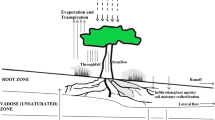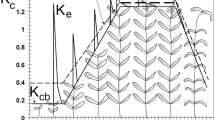Abstract
We conducted experiments to examine the quantitative relationships between rainfall event size and rainwater uptake and use by four common native plant species of the Colorado Plateau, including two perennial grasses, Hilaria jamesii (C4) and Oryzopsis hymenoides (C3), and two shrubs, Ceratoides lanata (C3), and Gutierrezia sarothrae (C3). Specifically, we tested the hypothesis that grasses use small rainfall events more efficiently than shrubs and lose this advantage when events are large. Rainfall events between 2 and 20 mm were simulated in spring and summer by applying pulses of deuterium-labeled irrigation water. Afterwards, pulse water fractions in stems and the rates of leaf gas exchange were monitored for 9 days. Cumulative pulse water uptake over this interval (estimated by integrating the product of pulse fraction in stem water and daytime transpiration rate over time) was approximately linearly related to the amount of pulse water added to the ground in all four species. Across species, consistently more pulse water was taken up in summer than in spring. Relative to their leaf areas, the two grass species took up more pulse water than the two shrub species, across all event sizes and in both seasons, thus refuting the initial hypothesis. In spring, pulse water uptake did not significantly increase photosynthetic rates and in summer, pulse water uptake had similar, but relatively small effects on the photosynthetic rates of the three C3 plants, and a larger effect on the C4 plant H. jamesii. Based on these data, we introduce an alternative hypothesis for the responses of plant functional types to rainfall events of different sizes, building on cost-benefit considerations for active physiological responses to sudden, unpredictable changes in water availability.







Similar content being viewed by others
References
BassiriRad H, Tremmel DC, Virginia RA, Reynolds JF, de Soyza AG, Brunell MH (1999) Short-term patterns in water and nitrogen acquisition by two desert shrubs following a simulated summer rain. Plant Ecol 145:27–36
Brown JH, Valone TJ, Curtin CG (1997) Reorganization of an arid ecosystem in response to recent climate change. Proc Natl Acad Sci USA 94:9729–9733
Caldwell MM, White RS, Moore RT, Camp LB (1977) Carbon balance, productivity; water use of cold-winter desert shrub communities dominated by C3 and C4 species. Oecologia 29:275–300
Chesson P, Huntly N (1989) Short-term instabilities and long-term community dynamics. Trends Ecol Evol 4:293–298
Cody ML (1989) Growth-form diversity and community structure in desert plants. J Arid Environ 17:199–210
Coleman ML, Shepard TJ, Durham JJ, Rouse JE, Moore GR (1982) Reduction of water with zinc for hydrogen isotope analysis. Ann Chem 54:993–995
Comstock J, Ehleringer JR (1986) Canopy dynamics and carbon gain in response to soil water availability in Encelia frutescens Gray, a drought-deciduous shrub. Oecologia 68:271–278
Cowling RM, Esler KJ, Midgley GF, Honig MA (1994) Plant functional diversity, species diversity and climate in arid and semi-arid southern Africa. J Arid Environ 27:141–158
Cui M, Caldwell MM (1997) A large ephemeral release of nitrogen upon wetting of dry soil and corresponding root responses in the field. Plant Soil 191: 291–299
Dodd MB, Lauenroth WK, Welker JM (1998) Differential water resource use by herbaceous and woody plant life forms in a shortgrass steppe community. Oecologia 117:504–512
Dougherty RL, Lauenroth WK, Singh JS (1996) Response of a grassland cactus to frequency and size of rainfall events in a North American shortgrass steppe. J Ecol 84:177–183
Easterling DR, Meehl GA, Parmesan C, Changnon SA, Karl TR, Mearns LO (2000) Climate extremes: observations, modeling, and impacts. Science 289:2068–2074
Ehleringer JR (1983) Ecophysiology of Ameranthus palmeri, a Sonoran Desert summer ephemeral. Oecologia 57:107–112
Ehleringer JR, Phillips SL, Schuster WSF, Sandquist DR (1991) Differential utilization of summer rains by desert plants, implications for competition and climate change. Oecologia 88:430–434
Ehleringer JR, Roden J, Dawson TE (2000) Assessing Ecosystem-level water relations through stable isotope ratio analysis. In: Sala OE, Jackson RB, Mooney HA, Howarth RW (eds) Methods in ecosystem science. Springer, Berlin Heidelberg New York, pp 181–214
Fowler AM, Hennessy KJ (1995) Potential impacts of global warming on the frequency and magnitude of heavy precipitation. Nat Hazards 11:283–303
Gebauer RLE, Ehleringer JR (2000) Water and nitrogen uptake patterns following moisture pulses in a cold desert community. Ecology 81:1415–1424
Gebauer RLE, Schwinning S, Ehleringer JR (2002) Interspecific competition and resource pulse utilization in a cold desert community. Ecology 83:2602–2616
Golluscio RA, Sala OE, Lauenroth WK (1998) Differential use of large summer rainfall events by shrubs and grasses: a manipulative experiment in the Patagonian steppe. Oecologia 115:17–25
Groisman PY, Karl TR, Easterling DR, Knight RW, Jamason PF, Hennessy KJ, Suppiah R, Page CM, Wibig J, Fortuniak K, Razuvaev VN, Douglas A, Forland E, Zhai P-M (1999) Changes in the probability of heavy precipitation: important indicators of climatic change. Climatic Change 42:243–283
Heckathorn SA, DeLucia EH, Zielinski RE (1997) The contribution of drought-related decreases in foliar nitrogen concentration to decreases in photosynthetic capacity during and after drought in prairie grasses. Physiol Plant 101:173–182
IPCC (1996) Climate change 1995. Contribution of working group I to the second assessment report of the Intergovernmental Panel on Climate Change. Cambridge University Press, Cambridge
Lauenroth WK, Sala OE, Milchunas DG, Lathrop, RW (1987) Root dynamics of Bouteloua gracilis during short-term recovery from drought. Funct Ecol 1:117–124
Lin G, Phillips SL, Ehleringer JR (1996) Monsoonal precipitation responses of shrubs in a cold desert community on the Colorado Plateau. Oecologia 106:8–17
Pierson EA, Turner RM (1998) An 85-year study of saguaro (Carnegiea gigantea) demography. Ecology 79:2676–2693
Reynolds JF, Virginia RA, Kemp PR, de Soyza AG, Tremmel DC (1999) Impact of drought on desert shrubs: effects of seasonality and degree of resource island development. Ecol Monogr 69:69–106
Sala OE, Lauenroth WK (1982) Small rainfall events: an ecological role in semiarid regions. Ecology 53:301–304
Schulze E-D, Hall AE (1982) Stomatal responses, water loss and CO2 assimilation rates of plants in contrasting environments. In: Lange O, Nobel PS, Osmond CB, Ziegler H (eds) Water relations and carbon assimilation. Encyclopedia of plant physiology 12B. New series. Springer, Berlin Heidelberg New York, pp 181–230
Schwinning S, Davis K, Richardson L, Ehleringer JR (2002) Deuterium enriched irrigation indicates different forms of rain use in shrub/grass species of the Colorado Plateau. Oecologia 130:345–355
Sokal RR, Rohlf FJ (1995) Biometry. The principles and practice of statistics in biological research, 3rd edn. Freeman, New York
Swetnam TW, Betancourt JL (1998) Mesoscale disturbance and ecological response to decadal climate variability in the American Southwest. J Climate 11:3128–3147
Turner RM (1990) Long-term vegetation change at a fully protected Sonoran (Mexico) desert site. Ecology 71:464–477
Wan C, Sosebee RE, McMichael BL (1993) Growth, photosynthesis, and stomatal conductance in Gutierrezia sarothrae associated with hydraulic conductance and soil water extraction by deep roots. Int J Plant Sci 154:144–151
Wong SC, Cowan IR, Farquhar GD (1979) Stomatal conductance correlates with photosynthetic capacity. Nature 282:424–426
Acknowledgements
This work was supported by the National Science Foundation (IBN 9814510). We would like to thank Danielle Pierce and Kim Davis for their important contributions to field and laboratory work and two anonymous reviewers who greatly helped us find our focus in the presentation of this study.
Author information
Authors and Affiliations
Corresponding author
Rights and permissions
About this article
Cite this article
Schwinning, S., Starr, B.I. & Ehleringer, J.R. Dominant cold desert plants do not partition warm season precipitation by event size. Oecologia 136, 252–260 (2003). https://doi.org/10.1007/s00442-003-1255-y
Received:
Accepted:
Published:
Issue Date:
DOI: https://doi.org/10.1007/s00442-003-1255-y




